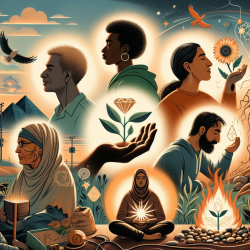Introduction
In the face of global disasters, culturally diverse children and youth are disproportionately affected. According to the United Nations Office for Disaster Risk Reduction, over 100 million young people are impacted by disasters annually. The research article "Cultural Factors in Disaster Response Among Diverse Children and Youth Around the World" highlights the critical role of cultural factors in shaping disaster response and recovery. This blog aims to provide practitioners with actionable insights to enhance their skills and encourage further research in this area.
The Role of Culture in Disaster Response
Culture significantly influences how communities perceive and respond to disasters. The study underscores the importance of cultural humility, awareness, and sensitivity in addressing the traumatic impacts of disasters on children and youth. Practitioners must understand that cultural beliefs and practices shape coping mechanisms and the acceptance of external aid, particularly mental health services.
Key Findings and Implications for Practitioners
- Understanding Cultural Worldviews: Different cultures have unique worldviews about the causality of disasters. For instance, Native American cultures emphasize harmony with nature, while some Middle Eastern cultures may exhibit fatalistic attitudes. Practitioners should be aware of these perspectives to tailor interventions effectively.
- Communication and Language Barriers: Effective communication is crucial in disaster response. The research highlights the need for multilingual communication strategies to ensure that all community members, including non-native speakers, receive vital information. Practitioners should advocate for inclusive communication practices.
- Infrastructure and Resource Allocation: The lack of infrastructure in low-resource settings exacerbates the impact of disasters. Practitioners should work with local communities to develop culturally appropriate disaster preparedness plans that address these challenges.
- Nutritional and Healthcare Needs: Cultural preferences influence dietary and healthcare practices. During disasters, practitioners should ensure that emergency food supplies and healthcare services align with cultural norms to prevent additional stress and health issues.
Encouraging Further Research
The research article provides a comprehensive overview of cultural factors in disaster response, but there is a need for ongoing research to explore these dynamics further. Practitioners are encouraged to engage in studies that investigate the long-term effects of culturally sensitive interventions on children's recovery and resilience.
Conclusion
Incorporating cultural sensitivity into disaster response is essential for improving outcomes for children and youth. By understanding and respecting cultural values, practitioners can enhance the effectiveness of their interventions and support the mental health and well-being of young disaster survivors.
To read the original research paper, please follow this link: Cultural Factors in Disaster Response Among Diverse Children and Youth Around the World.










